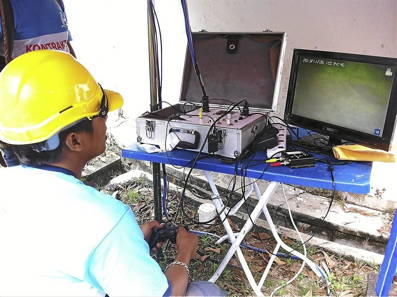 Cleanzine: your weekly cleaning and hygiene industry newsletter 25th April 2024 Issue no. 1111
Cleanzine: your weekly cleaning and hygiene industry newsletter 25th April 2024 Issue no. 1111
Your industry news - first
The original and best - for over 20 years!
We strongly recommend viewing Cleanzine full size in your web browser. Click our masthead above to visit our website version.
Underwater robotic cleaner will ensure continuity of water supply
 A new underwater robotic cleaner will ensure that there will be no more water supply disruptions during scheduled cleaning of water reservoirs and tanks, says Syarikat Bekalan Air Selangor Sdn Bhd's (Syabas) of Malaysia.
A new underwater robotic cleaner will ensure that there will be no more water supply disruptions during scheduled cleaning of water reservoirs and tanks, says Syarikat Bekalan Air Selangor Sdn Bhd's (Syabas) of Malaysia.
Known as the Underwater Tank Cleaning Robot, the machine will suck out sludge and sediment from the bottom of reservoirs and water tanks, eliminating the need for them to be drained first.
Equipped with a light, camera, brush and a suction system, this locally designed-and-made robot moves along on the floor of the tank, where it is monitored through a screen synchronised to the robot's built-in camera and controlled by an operator using a joystick, who will move it around the tank to ensure it cleans thoroughly.
"The robot operates inside the tank and cleans without disrupting the water supply," WQ Enterprise Sdn Bhd owner Mai Thean Loon told the Malasian Star. "So far, it can only move on a horizontal surface and not on the walls yet. That feature is still a work in progress."
The 52-year-old engineer invented the underwater robot with the help of Universiti Tun Hussein Onn Malaysia (UTHM) students, finishing the first prototype in 2004. Over time, he improved the design and sold the robot to other countries such as the Philippines. He then worked with water concessionaires in Johor, offering them his cleaning services. Slowly, he expanded his business to other states including Sarawak, Pahang, Penang and Selangor.
In Selangor, he has helped water concessionaires Puncak Niaga Holdings Bhd and Syabas clean and maintain water reservoirs, dams, treatment plants and tanks.
"This cleaning method is effective and easy. It does not require much power or manpower," he told The Star reporter, explaining that the duration of the cleaning process depends upon the size of whatever is being cleaned... For a tank holding about one million gallons of water, cleaning takes up to five days, while for bigger areas such as water treatment plants or water-holding areas, cleaning can take months at a time.
"It depends on the sediment as well," he added. "If it is thick and has not been cleaned for over 20 years, then it will take months to clean even a small reservoir."
He explained that the plastic robot was hooked up to a vertically suspended hose, which channels dirt and sediments out of the reservoir.
"We do not use metal, only plastic, to prevent bacteria or rust from polluting the water," he explained.
The machine is washed thoroughly with chlorine before it is fed in through the manhole opening.
Syabas water quality department senior manager Roskhandi Kamaluddin, told The Star: "Hourly checks and water sampling will be carried out to ensure the water is not contaminated."
He explained that water sampling would be taken at three different places; at the reservoir or tank, at water outlets and at sampling stations found in residential areas.
"So far, everything is working well, and there are no complaints from consumers about water disruptions during our cleaning process," he said.
Syabas engaged Mai's company in 2010, where discussions on how and where to clean lasted for two years. In 2012, Syabas started using the underwater robot cleaner and has cleaned 10 reservoirs so far, which had been identified as critical.
One was in Klang, one in Shah Alam, four in Kuala Lumpur and another four in Hulu Langat.
"This is definitely a better way to clean as it eliminates the risk of contamination as compared to manual cleaning," said Roskhandi, confirming that Syabas would continue using this robotic method of cleaning, starting with the critical areas first and afterwards following an annual maintenance schedule, dubbed the Air Scouring Programme, which will also involve the occasional sampling and analysis of water quality.
Image courtesy of The Star
28th November 2013







